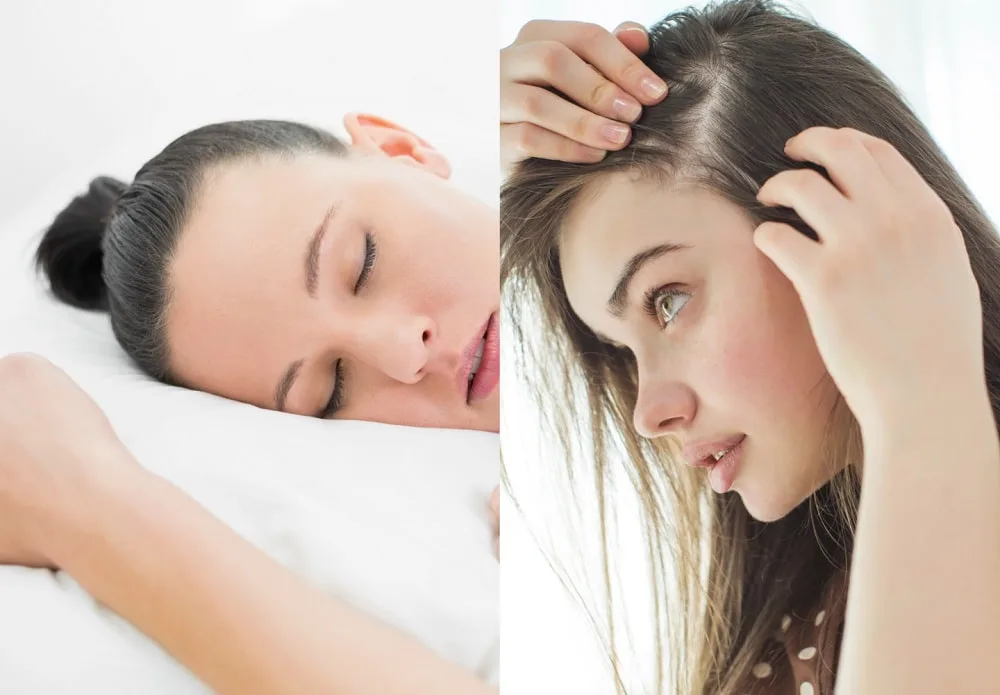Keeping hair tied up all the time is pretty common for people with long hair. It can get tangled or swing and blow into your face at inconvenient times, so it’s often easier to tie it up out of the way.
However, since 52.2% of women and over 80% of men experience significant hair loss, it’s important to avoid unnecessarily contributing to this loss.
Certain hairstyles may cause more significant hair loss and damage than others. It can be even worse to wear your hair tied up at certain times of the day.
Is Keeping Your Hair Tied Up All Day Damaging?
Yes! Keeping hair tied up all the time can cause permanent damage or hair loss, especially if your hair is tied up tightly and in the same position every day.
Tight ponytails, buns, or braids put pressure on your hair’s roots, and the elastic hair bands cause friction on your hair. These factors and more contribute to hair damage.
What Happens When You Keep Hair Tied Up All the Time?

When you wear a tight hairstyle all day, it puts strain on your hair’s roots. These hairstyles include:
- Tight ponytails
- Ponytails worn in the same place every day
- Buns
- Tight braids, such as cornrows or box braids
- Weaves
Wearing a tight hairstyle now and then won’t cause any long-term damage, but if you wear these hairstyles daily, over time, your hair can become damaged from the constant tension.
Additionally, the elastic rubs on your hair and the continuous friction can cause your hair to break and fray. This damage is responsible for flyaways and frizzy hair.
In extreme cases, you could develop traction alopecia, a condition caused by repeated tension on the hair. It often results in permanent hair loss. This condition is most commonly seen when hair is repeatedly worn in tight hairstyles, especially when hair is regularly exposed to heat or chemicals.
Symptoms include itching, bumps, soreness, or redness on your scalp as well as inflammation of the hair follicles.
To avoid traction alopecia, switch up your hairstyle often. Wear your hair down, or if putting it in a ponytail or bun, keep it low and loose and switch up where it’s positioned on your head each day.
Is It Bad to Wear Your Hair Up While Sleeping?

Everything that applies to wearing your hair up during the day also holds true at night. In truth, it is even worse to wear tight hairstyles at night. During the day, you have only the tension of the hairstyle and the friction of the hair bands.
However, at night, you add extra tension to your roots whenever you move your head on the pillow. Each time you roll over, you put extra stress on your roots that they don’t have during the day.
Additionally, as your head moves on your pillow, you have extra friction along any part of your hair touching the pillow. While you will still have a small amount of friction with your hair down, loose hair is more able to flow along with your movement.
Hair that is tied up, on the other hand, is locked in place and gets rubbed against the pillow every time you move.
Make sure your hair is dry when you go to sleep since wet hair is more fragile, and sleep with it down, in a loose braid, or covered with a cap or bonnet. Using a silk pillowcase also causes less friction on the hair than cotton or flannel pillowcases.
So, Is It Better to Tie Your Hair Up or Down?
Wearing your hair down and loose is the best way to avoid the damage from tight hairstyles. When you need to tie your hair up, make sure to choose low and loose ponytails, buns, and braids.
If you wear it up on consecutive days, switch up your style and position on your head so that you aren’t putting strain on the same areas each day. By doing this, you can avoid traction alopecia and subsequent hair loss.
